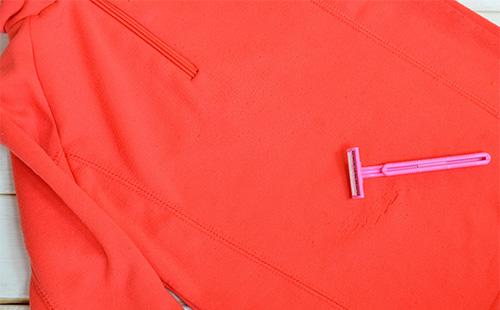The content of the article
To give clothes a second life, you can use a special machine. This device effectively and efficiently cuts all unaesthetic nodules. And at the same time it does not damage the product at all. The machine provides for height adjustment, which allows you to care even for embossed fabrics. But if such an apparatus is not in the house, improvised means will come to the rescue, with the help of which it is possible to “reanimate” clothes at least qualitatively.
Reasons for rolling and methods of prevention
How to get rid of coils on trousers and knitted clothes and what to do with spools on a jacket? The best method is to prevent them from appearing. And in order to protect your favorite thing, it is important to understand why the spools can form on it. It is equally useful to get acquainted with some tricks that will significantly extend the life of dresses and pullovers.
Why ugly nodules appear
It is believed that unaesthetic spools occur only on poor-quality clothing. Such a stereotype is easily destroyed by observations from practice. Indeed, even on natural and expensive clothing, such nodules can appear. The reasons for the formation of spools on clothing are usually hidden in such factors.
- Features of the fabric. Some materials are prone to ugly nodules. Most often, spools are observed on knitted and woolen things. A similar problem occurs on mixed-type fabrics when synthetic threads are diluted with natural ones.
- Manufacturing defects. Sometimes there may be areas in which long broaches or stiffly twisted threads are noted. It is in these places that the first nodules will begin to form. To determine such areas by eye, it is enough to carefully examine the fabric before buying, stretching it in front of the light source.
- External factors. Rolling can be triggered by excessive friction. Most often, the first spools appear on the sweater at the place of contact with the strap from the bag or on the belt of the pants as a result of the belt.
- Improper care. All things have a tag. It contains valuable information on the washing mode, permissible temperatures. The manufacturer usually indicates whether spinning is allowed and at what speed. Failure to comply with such rules often results in the appearance of a variety of unpleasant defects, including the appearance of spools.
How to take care of things so that the problem does not arise
According to reviews, it is much easier to prevent the appearance of spools on clothing than to fight them. The following recommendations will help protect your belongings from spoilage.
- Follow the manufacturer's advice. Always try to follow the directions for product care.
- Do not use hot water. It is completely undesirable to wash things at high temperatures. This is only permissible in extreme cases.
- Put the sweater in the freezer. Despite the seeming absurdity of such an event, it will effectively help prevent the appearance of spools. It is necessary to keep a new thing in the freezer on a tray or in a bag for ten hours. Then it is immersed in warm water and allowed to thaw. This procedure will not only prevent the appearance of knots, but also make the new sweater less “biting”.
- Remove nodules in a timely manner. It is much easier to remove spools that are still barely noticeable than those that have already been “hardened” with several washings.
- Choose the right powders. For washing clothes, it is recommended to choose powders, the labeling of which contains the note “softening the fabric fibers”.
- Try dry cleaning. In order not to be tormented by the question of how to properly wash and remove the spools from a coat or other expensive thing, it is better to use the services of a professional dry cleaning service.
How to remove the spools from clothes: 6 basic devices
You can remove the spools from the clothes after washing only mechanically. And in order not to damage the product, it is better to use a shaver - that same machine to eliminate ugly nodules. In the absence of such, you can resort to the help of improvised means, which, apparently, are not even suitable for this. But this is only at first glance.

Razor
Features If the choice fell on a razor, then all attention and accuracy will be required. It is very easy for them to damage the fabric. Therefore, for delicate and very expensive products, this method is better not to use. Also, it is not suitable for things from mohair, angora. Usually a razor is used to remove spools from small woolen things: socks, hats, mittens, gloves, tights.
Removal Technique
- The site of the product with nodules needs to be greatly stretched.
- Gently touch the razor fabric. Trying to “shave off” the nodules by touching the surface of the product a little.
- You need to move from the bottom up.
Scissors
Features You can remove the spools without a razor. If the nodules are quite large, then they are easy to cut with scissors. This method will help to restore the beautiful appearance of things that have a complex texture, corrugated pattern or containing various decor items.
Removal Technique
- The product is placed on a flat surface, slightly stretching the damaged areas with nodules.
- Holding the scissors strictly parallel to the fabric, they begin to cut the spools. The procedure requires great care, because any awkward movement can provide the appearance of puffs.
- It is recommended to initially process large surfaces. And only then they go on to cleanse the tissue from nodules on small details: sleeves, neck.
Toothbrush
Features How to remove the spools from a sweater from mohair or angora without damaging it? Such products can be put in order with a conventional toothbrush. The method is long, but very effective. In order not to damage the product, you need to choose a brush with a soft bristle. Initially, it is scalded with boiling water and carefully dried.
Removal Technique
- The product is laid out on a horizontal surface, trying to stretch it a little.
- Toothbrush begin to "comb" the fabric. You need to move strictly in the direction of the pile. If cleaning is carried out in a chaotic manner, the product will be irreversibly damaged.
- To eliminate the spools, you need to brush the fabric several times.
- To restore the “fluffiness” it is recommended to soak the product in the following solution: for three liters of water - 70 ml of 6% vinegar.
Hairbrush
Features The method eliminates the spools without a machine. It is not entirely convenient and is strictly prohibited for delicate fabrics. It is best used for large knit sweaters, woolen hats.
Removal Technique
- The product is stretched on the table surface.
- A flat comb with small teeth is placed horizontally above the fabric.
- Begin to "comb." Spools will appear between the teeth.
- Small nodules easily come off on their own. To eliminate large ones, it is better to additionally use manicure scissors. Otherwise, puffs may remain.
Scotch
Features How to quickly remove spools from clothes? You can use scotch tape. This remedy for spools on clothes “works” on the principle of wax strips for depilation or a sticky roller, effectively removing animal hair, spools, hair from the product. You can use this method for coats, hats, knitwear or wool. But scotch tape can only cope with "fresh" nodules. He does not eliminate the elderly.
Removal Technique
- Cut a piece of wide tape.
- They wrap their palm so that the sticky surface is outside.
- The fabric is laid out on the table, carefully spreading the damaged area.
- A sticky layer of adhesive tape is applied to the spools. Diligently crush it with his palm to the surface of the fabric.
- Then, in one sharp movement, the adhesive tape is torn off the surface.

Sandpaper
Features To effectively eliminate the spools, you can use another life hack. Remove the nodules will allow sandpaper. But it is necessary to apply exclusively fine-grained cloth. Only those products that will not become “shaggy” are subject to sandpaper cleaning.
Removal Technique
- On the fabric laid out on the table, spend fine-grained sandpaper.
- The cloth with adhered spools is cleaned whenever possible.
- The event is repeated.
When thinking about how to get rid of spools from knitwear, wool or any other fabric, pay attention to pumice. She is able to put both heels and a sweater in order. The technique for eliminating unaesthetic nodules is uncomplicated and resembles the sandpaper technology.
There is another method for cleaning clothes from pellets. Special sticky clasps can be purchased at the store. Pile, animal hair, hair and nodules effectively adhere to such a surface. But cleaning in this way can only dense products such as coats and jackets.
Reviews: “The coolest way - a beard trimmer”
Spools often appear on clothes during socks, which spoil the look. However, getting rid of them is not difficult.
There are special machines for removing spools, but you can make it easier.
You need to take a shaving machine (any, even cheap disposable razors will do) and carefully so as not to cut the threads, shave the spools.After that, the clothes can be additionally cleaned with the sticky side of the adhesive tape by wrapping it in a hand - this will help get rid of dust and pile residues.
AV, https://otvet.mail.ru/question/57315088
And I know another method, I used it myself. So, you need to wet a new sweater and put it on a tray, then in the freezer for about 6 hours. Then you need to lower it in warm water so that it completely “thaws”. There will be no reels on such a jumper and the jumper will become very soft!
NSV0506, http://www.bolshoyvopros.ru/questions/49706-kak-borotsja-s-katyshkami-na-odezhde.html
Scissors do not always succeed in removing the spools.I'm a loom so-and-so. But she also used the machine. So-so, although maybe there are good ones, dear ones. Mine is cheap, it cost a hundred rubles.
Bun cat, https://lady.mail.ru/forum/topic/mashinka_dlja_udalenija_katyshkov/
I found the coolest way !! Husband trimmer for modeling a beard with a small nozzle - and a woolen dress as new! And then all the sweaters, hats and more!
Victoria, http://www.woman.ru/home/medley9/thread/4266250/

